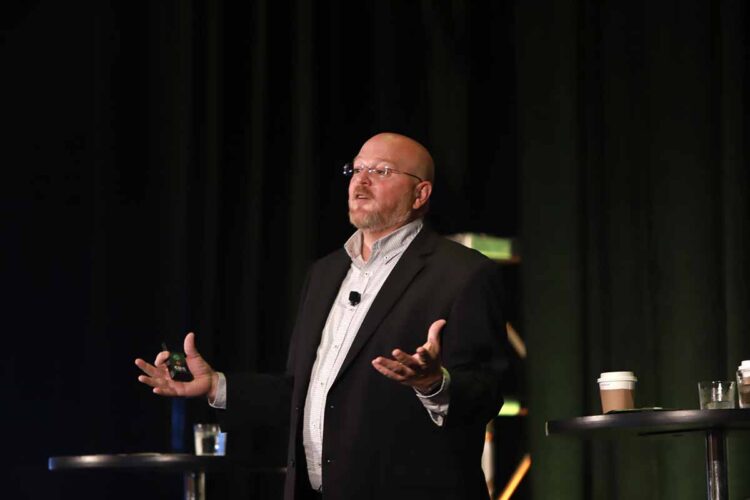More than 1,000 e-scrap and ITAD leaders are gathering this week in New Orleans, with much of the discussion focusing on business opportunities tied to wider circular economy trends.
The 2022 E-Scrap Conference kicked off yesterday, and the day’s final session delved into the strategies of two processing firms that have both announced growth plans of late. Leaders from the companies, evTerra and GreenChip, indicated that they are focused on helping OEMs and other clients meet their sustainability goals.
One key for electronics reuse and recycling businesses looking to capitalize on the current sustainability push is meeting clients where they are in terms of tracking and reporting sustainability metrics, said Chris Kaasmann, vice president of compliance at GreenChip
GreenChip is an electronics processor with locations in Brooklyn, N.Y. and Fredericksburg, Va. The company is planning a significant Virginia expansion, and corporate sustainability is central to its vision.
“There’s many different ways to track sustainability, so listening to what they want and putting that into tools that are accessible to them is super important,” said Kaasmann, who previously worked for four years at Samsung, where he and others spent a lot of time thinking about environmental, social and governance (EGS) and the circular economy.
Kaasmann was joined on the “Emerging Processing Models” session by Jeff Gloyd, who is the president of evTerra, which launched last year as part of a vertically integrated electronics recycling venture with smelter Igneo (the companies are now owned by metals giant Korea Zinc). The evTerra division has a goal to open four facilities by the end of this year.
Gloyd noted that OEMs and other large brands want to use recycled content in their products to meet their ESG goals, but “it comes down to the financial conversation or it’s not going to happen.” If an OEM is putting 40% recycled resin in a printer, for instance, that’s because the company has conducted a study that shows it will sell more printers as a result, he said.
Therefore, the recycling industry needs to develop cost-effective, accessible solutions to supply that recycled material, he said.
Trending toward circular
Elsewhere at the first day of the event, workshops dived into a variety of critical trends confronting e-scrap and ITAD operators. Topics included facility fire safety, diversification of revenue streams, steps to certification, an inside look at the Latin American market and more.
During a workshop outlining the details of the R2 standard, Patty McKenzie, outreach director at Sustainable Electronics Recycling International (SERI), said certification “supports a circular economy, but more than that, it enriches lives and livelihoods because it provides affordable products to people who need them.”
Meanwhile, in the “What Right to Repair Means for Recyclers” workshop, Ted Briggs, strategy and sustainability lead for Google Pixel, said that while OEMs are interested in advancing the circular economy, “we’re still very much in the information-gathering stage and we haven’t found the silver bullet to these scalable solutions.”
“I look forward to greater partnership with your industry in the future to address some of these issues,” he added.
At the same session, Ryan Laber, vice president of business development at Cascade Asset Management, predicted that the circular economy will continue to be a growing focus for the industry.
“There’s money to be made,” Laber said. “There’s a lot of equipment that can be repaired.”
Fire focus
Of course, another element of the circular economy is effectively managing all that comes to recyclers at end-of-life. Increasingly, that task involves batteries.
The Institute of Scrap Recycling Industries (ISRI) organized a workshop for the first day of the conference, and it explored fire safety in facilities.
One workshop speaker tied brain science to battery-sparked fires. Bo Bodo, director of learning and development at battery recycling company Li-Cycle, explained that parts of the brain that govern decision-making give way to emotional centers when a lithium-ion battery fire breaks out.
As a result, a staff member may immediately grab a fire extinguisher with fire suppression chemicals.
“What you use for a lithium-ion battery fire is water,” he said, noting that the goal is to lower temperatures, so the heat doesn’t lead to combustion of parts of the battery or nearby materials.
He emphasized the importance of not just training employees on what to do but also how batteries work, the different kinds of cells there are, what happens during a thermal event, and why water prevents fires. Such knowledge will help them take the correct actions during a thermal event.
“Give them the why behind the what and your training programs will be much more effective,” he said.
Another session provided an overview of state extended producer responsibility (EPR) programs, particularly with regard to rural area collections and requirements for collection opportunities that meet state convenience standards.
Patrick Santelli, senior compliance program manager for Electronic Manufacturers Recycling Management Co. (MRM), noted that CRT weights in the end-of-life stream are dropping. As a result, it makes it more challenging for OEMs to hit weight targets and increases costs for OEMs without increasing recycling rates.
Convenience standards have been put in place in Illinois and South Carolina in place of weight-based targets. Through the convenience standards approach, the state mandates a certain number of e-scrap drop-off locations and collection events in different areas based on municipal jurisdictions and populations.
“I think as weight starts to become more scarce, I think it’s likely to see a greater adoption of convenience standards,” Santelli said.
Analysis of the intersection between electronics recovery and wider sustainability continues during the conference today and tomorrow.
A session this morning called “OEM Visions of a Circular Economy” will feature speakers from VIZIO, TCL North America, Ricoh USA and others. That discussion will focus on how equipment manufacturers are defining circularity and how the e-scrap and ITAD sectors fit in.
Another session, “The Circularity Economy in Action,” will give executives from processor URT and global manufacturing services company Jabil an opportunity to outline case studies in electronics sustainability, with materials recovery and reuse at the center of the conversation.
Other topics on tap for discussion today and tomorrow include the evolution in state e-scrap programs, shifts in global trade regulations, a wider look at the state of the e-scrap sector, and much more.

























